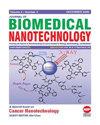Impact of Radiotherapy on Radiation-Induced Brain Injury in Patients with Nasopharyngeal Carcinoma Using Nano-Magnetic Resonance Imaging
IF 2.9
4区 医学
Q1 Medicine
引用次数: 0
Abstract
This study investigate the changes of white matter injury induced by radiation after radiotherapy in patients with nasopharyngeal carcinoma (NPC) and its association with cognitive dysfunction using multiple MRI methods. A total of 42 patients with NPC who underwent radiotherapy at xxx Hospital between December 2018 and June 2021 were included. The patients were randomly divided into 4 groups based on the timing of radiotherapy. Superparamagnetic iron oxide nanoparticles were used as MRI contrast agents. DTI and MRS scans were conducted to measure FA, ADC, NAA/Cho, Cho/Cr, and NAA/Cr ratios in the hippocampus of both temporal lobes. A cognitive assessment was performed using the MoCA and MMSE scales. After radiotherapy, patients experienced a decline in cognitive scores, which stabilized after 6 months. White matter changes were observed in the hippocampus, with decreased FA and increased ADC values that gradually returned to normal levels. Cho value increased and NAA value decreased initially but eventually returned to pre-treatment levels. No significant changes occurred in the Cr value. Metabolite ratios decreased within 3 months post-radiotherapy but gradually increased thereafter, remaining lower than pre-treatment levels at 6 months. Higher radiation doses did not significantly affect FA and ADC values but decreased white matter metabolite ratios. In conclusion, we reveal that the dosage and duration of radiotherapy can influence the degree of brain injury in patients with NPC and highlights the cognitive decline, white matter changes, and changes in metabolite ratios after radiotherapy for NPC, providing insights into the effects of radiation on brain structure and function.利用纳米磁共振成像分析放疗对鼻咽癌患者放射性脑损伤的影响
本研究采用多种核磁共振成像方法研究鼻咽癌患者放疗后辐射诱导的白质损伤变化及其与认知功能障碍的关系。共纳入2018年12月至2021年6月期间在xxx医院接受放疗的42例鼻咽癌患者。根据放疗时间将患者随机分为4组。超顺磁性氧化铁纳米粒子被用作磁共振成像造影剂。进行DTI和MRS扫描,测量两个颞叶海马的FA、ADC、NAA/Cho、Cho/Cr和NAA/Cr比率。使用MoCA和MMSE量表进行了认知评估。放疗后,患者的认知评分有所下降,6个月后趋于稳定。海马白质发生了变化,FA值降低,ADC值升高,并逐渐恢复到正常水平。最初,Cho 值升高,NAA 值降低,但最终恢复到治疗前的水平。Cr值没有发生明显变化。代谢物比率在放疗后3个月内下降,但之后逐渐上升,6个月时仍低于治疗前水平。较高的放射剂量对FA值和ADC值没有明显影响,但会降低白质代谢物比率。总之,我们揭示了放疗的剂量和持续时间会影响鼻咽癌患者的脑损伤程度,并强调了鼻咽癌放疗后的认知能力下降、白质变化和代谢物比值变化,为了解放疗对脑部结构和功能的影响提供了见解。
本文章由计算机程序翻译,如有差异,请以英文原文为准。
求助全文
约1分钟内获得全文
求助全文
来源期刊
CiteScore
4.30
自引率
17.20%
发文量
145
审稿时长
2.3 months
期刊介绍:
Information not localized
文献相关原料
| 公司名称 | 产品信息 | 采购帮参考价格 |
|---|

 求助内容:
求助内容: 应助结果提醒方式:
应助结果提醒方式:


